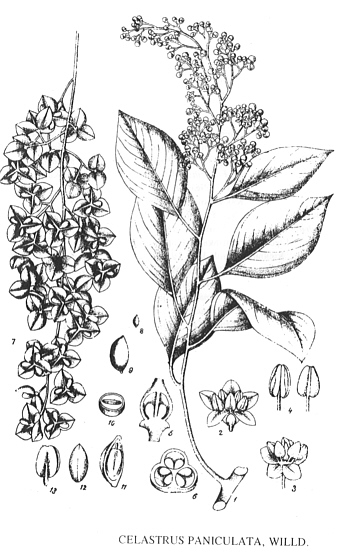

Zitierweise / cite as:
Carakasaṃhitā: Ausgewählte Texte aus der Carakasaṃhitā / übersetzt und erläutert von Alois Payer <1944 - >. -- Anhang A: Pflanzenbeschreibungen. -- Celastrus panniculata Willd. -- Fassung vom 2007-04-20. -- URL: http://www.payer.de/ayurveda/pflanzen/celastrus_panniculata.htm
Erstmals publiziert: 2007-03-19
Überarbeitungen: 2007-04-20 [Ergänzungen]; 2007-04-18 [Ergänzung]
Anlass: Lehrveranstaltung SS 2007
©opyright: Dieser Text steht der Allgemeinheit zur Verfügung. Eine Verwertung in Publikationen, die über übliche Zitate hinausgeht, bedarf der ausdrücklichen Genehmigung des Verfassers
Dieser Text ist Teil der Abteilung Sanskrit von Tüpfli's Global Village Library
WARNUNG: dies ist der Versuch einer
Übersetzung und Interpretation eines altindischen Textes. Es ist keine
medizinische Anleitung. Vor dem Gebrauch aller hier genannten Heilmittel wird
darum ausdrücklich gewarnt. Nur ein erfahrener, gut ausgebildeter ayurvedischer
Arzt kann Verschreibungen und Behandlungen machen!
Falls Sie die diakritischen Zeichen nicht dargestellt bekommen, installieren Sie eine Schrift mit Diakritika wie z.B. Tahoma.
Verwendete und zitierte Werke siehe: http://www.payer.de/ayurveda/caraka0001.htm

Abb.: Celastrus panniculata Willd
[Bildquelle: Kirtikar-Basu, ©1918]
Drury:
"Celastrus paniculata (Willd.) N. 0. Celastraceae. Staff-tree, Eng. Valuluvy, Tam. Bavungie, Tel. Malkunganee, Mink.
Description.—Climbing shrub, unarmed; young shoots and flower-bearing branches pendulous; leaves alternate, broadly oval, or ovate, or obovate, usually with a sudden short acumination, slightly serrated, glabrous; racemes terminal, compound or supra-decompound, elongated, much longer than the uppermost leaves; petals 5; calyx 5-partite; lobes rounded, ciliated; capsule globose, 3-celled, 3-C seeded; seeds with a complete arillus; flowers small, greenish. Fl. March—May.— W. & A. Prod. i. 158.—Wight Icon. t. 150.—Roxb. Fl. Ind. i. 621.—C. nutans, Roxb. Fl. Ind. i. 623.——Neilgherries. Hilly parts of the Concans. Dheyra Dhoon.
Medical Uses.—The seeds yield an empyreumatic oil (Oleum nigrum) used in lamps. It is said to be of a stimulant nature, and is used medicinally, having been found a successful remedy in beriberi. The seeds, owing to a resinous principle, have a very hot and biting taste. Royle says the oil is a stimulant and useful medicine: It is of a deep scarlet colour. It is administered in doses of a few drops daily in emulsion.—(Royle. Malcolmson.) The oil is principally used for horses; also for rheumatism and paralysis. It acts as a powerful diaphoretic and tonic. The oil is made by putting the seeds with benzoin, cloves, nutmegs, and mace into a perforated earthen pot, and then obtaining by distillation into another pot below a black empyreumatic oil,—Powells Punj. Prod."
[Quelle: Drury, Heber <1819 - 1872>: The useful plants of India : with notices of their chief value in commerce, medicine, and the arts. -- 2d ed. with additions and corrections. London : Allen, 1873. -- xvi, 512 p. ; 22 cm. -- s.v.]